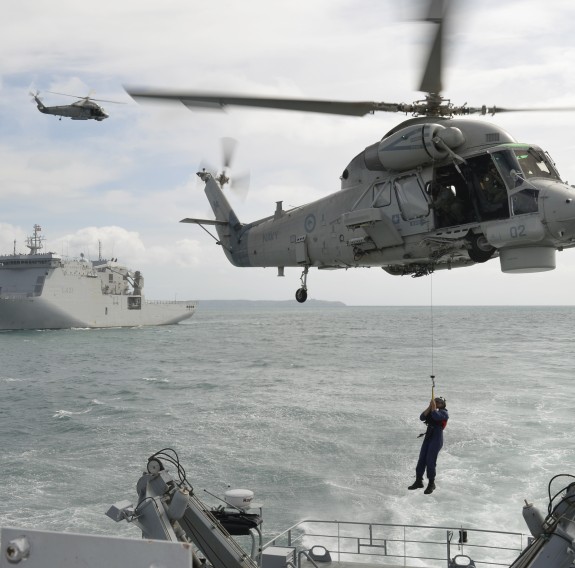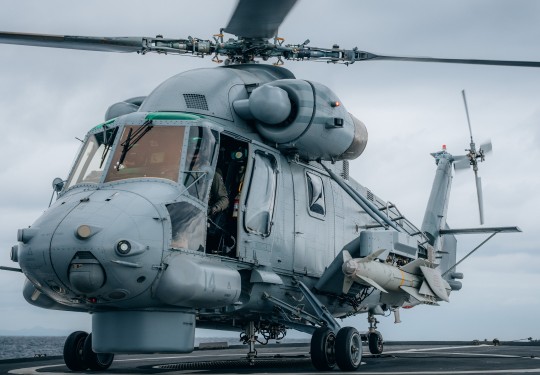No. 6 Squadron – Vigilance with Patience
This year marks a significant milestone for No. 6 Squadron RNZAF, celebrating 20 years since its reestablishment as the Royal New Zealand Navy’s maritime helicopter unit.
21 November, 2025
But as an aviation squadron, its history goes back even further – forming, disbanded and reforming several times, adapting to the changing demands of New Zealand’s military aviation requirements.
First established in February 1942, the Squadron began as an Army cooperation unit flying Vickers and Hawker biplane trainers before converting to Catalina amphibious aircraft a year later. Operating across the Pacific Islands throughout the Second World War, the Catalinas of No. 6 Squadron played a vital role in reconnaissance, search and rescue, and maritime patrol missions.
At the end of hostilities, the Squadron transitioned to the Short Sunderland flying boats, continuing its maritime surveillance role until 1957, when No. 6 Squadron was disbanded and its aircraft transferred to No. 5 Squadron. The Sunderland’s were eventually replaced by the P-3 Orion in 1967, marking a new era in long-range maritime patrol for the Royal New Zealand Air Force.
Meanwhile, the Royal New Zealand Navy was developing its own airborne capability with the purchase of frigates with flight decks. In 1966, HMNZS Waikato became the first RNZN vessel to embark the Westland Wasp anti-submarine helicopter. This changed the role of a combat frigate to include being a platform to deliver Naval Aviation Combat capabilities.
No. 3 Squadron, which had become a dedicated helicopter squadron, operated the Wasp helicopters for the next three decades.
At the time, maintaining the Naval Support Flight (NSF) within 3 Squadron made sense with the number of aircraft and the technical needs to support them leading naturally to finding capacity from within an existing Squadron rather than commissioning a new one. Co-location at Hobsonville also made sense despite the outputs of NSF being very distinct from those provided through Iroquois operations.
When the Wasps retired in 1998, they were replaced by the Kaman SH-2F Seasprite as an interim measure before the new the SH-2G(NZ) were delivered. For the Commander of the Naval Support Flight at the time, Lieutenant Commander Jim Gilmour, the new helicopters were a real pleasure to fly.
“They were an extraordinary leap forward in terms of capability - range and endurance, twin engine, radar, FLIR, ESM, self protection, data link (such as it was) and Anti-ship missiles (Maverick) all made the transition a positive experience,” he said.
With the arrival of the Seasprite, it was obvious that Naval Aviation had matured and expanded significantly.



When the relocation of Iroquois operations to Ohakea occurred along with the move of the Naval Support Flight from Hobsonville to Whenuapai, it became clear to LTCDR Gilmour, that a new squadron was needed.
“I considered this a reflection of the emergence of a critical strand of Naval combat outputs and deserving of the status and support that a separate entity should bring.”
In 2004, LTCDR Gilmour piloted his last Seasprite flight and concluded his time with the NSF unit taking up the Director Naval Aviation position in Wellington on promotion to Commander. While he moved between these roles, his key objective was to petition the Chief of Air Force at the time to establish a new squadron.
“I spent a great deal of time forming the argument and was proud to convince CAF of its merits and to see the re-establishment of No. 6 Squadron as a dedicated naval aviation unit take place shortly after.”
The re-establishment of the Squadron in October 2005 marked a new chapter in joint Air Force–Navy cooperation, integrating RNZN aircrew with RNZAF maintenance personnel to deliver a seamless maritime aviation capability.
By that stage, five of the SH-2G(NZ) Seasprite variants had joined the fleet and then In 2015, ten ex-Royal Australian Navy SH-2G(I) Seasprites were acquired to replace the NZ type, expanding the Squadron’s capability and reach.
Today, No. 6 Squadron currently supports HMNZ ships Te Kaha, Te Mana, Canterbury and Aotearoa in operations ranging from anti-surface and anti-submarine warfare to search and rescue, surveillance, maritime sustainment and disaster relief.
The 20th anniversary of the Seasprite squadron also coincides with the Government’s recent announcement of the Sikorsky MH-60R Seahawk as the replacement for the Seasprite fleet. This ensures that No. 6 Squadron will continue to deliver world-class maritime helicopter capability well into the future. The transition will enhance interoperability with allies, particularly the Royal Australian Navy, which also operates the MH-60R.
For the Commanding Officer, Commander Alex Trotter, the anniversary is one which arrives during a busy and rewarding period for the unit.
“With a flight deployed on operations in the South China Sea, and the rest of the squadron conducting mountain flying training in the South Island, it’s the perfect example of the wide spectrum of capabilities the squadron provides in diverse operating environments,” he said.
“It’s important we reflect on 20 years of achievements in delivering a warfighting capability to the Royal New Zealand Navy, as well as the myriad of other outputs to various stakeholders within the NZDF and other government agencies. And it’s equally appropriate we recognise our personnel – the sailors, aviators and civilians. Their professionalism, dedication and adaptability remain at the heart of the Squadron’s success.”
